As the epidemic is drawing to a close, we have a reflection on the digital system

By Cui Jie (General Manager, Xita Technology Beijing Branch)
Editor / Chen Duxiu
Editor's note
- Why is the central bank's blockchain patent ranked first in the world's central bank?
- Blockchain Industry Weekly Report | Central Bank Officially Releases "Technical Specifications for Financial Distributed Ledger Security"
- Eighth issue: insight into the major changes in financial infrastructure in the next 10 years (on)
The "continuous drop" data outside Hubei Province indicates that the epidemic has come to an end.
It can be said that this epidemic is a big test for the digital government. No matter how high the normal mock test scores are, once the test is closed, the so-called "no need to run once" and "cloud on xx" dwarf immediately. Digitization is to improve the transparency of information and improve the operational efficiency of social information flow, capital flow, and logistics. As long as our digital system does not solve these basic problems, it can basically be classified as a brilliant technology.
After bearing the huge price, we should start to reflect on what made us react slowly, and when the next major disaster comes, can we be faster than we are now?
Below, the zinc link recommends to readers the research report of Cui Jie, general manager of Xita Technology Beijing Branch, "What can the blockchain do for the epidemic? ", This article is the exclusive contribution of Cui Jie and Xita Science and Technology Research Institute for the zinc link. If you need to reprint, you need the author's authorization.
Since the first case of pneumonia of unknown cause, to the outbreak of the epidemic, some difficult control and more complicated management situations have emerged, such as the problem of reporting and publishing epidemic information, the receipt and distribution of material donations, large personnel movements, and personnel flow Information credibility and integrity are not high.
The natural attributes of the blockchain determine that it can play a crucial role in the management of these issues. Therefore, according to the epidemic, the Xita Institute of Science and Technology has proposed four topics of research value, the details are as follows.
1. Infectious disease direct reporting system + early warning function that can be “horizontal sharing”
After experiencing the SARS epidemic in 2003, the government spent heavily on establishing the China Infectious Diseases and Public Health Emergency Surveillance Information System (referred to as the network direct reporting system), which monitors and reports various infectious diseases. It is the focus of monitoring and reporting. The direct network reporting system covers all disease prevention and control institutions at or above the county level, and 98% of medical institutions at or above the county level and 96% of township health centers.
These hospitals can click to report cases in the network system. The Chinese CDC can receive them as soon as they do not have to go through gradual approval. Moreover, the CDC has a group of people who specialize in monitoring the system. If there are more than 5 cases of pneumonia, the verification mechanism will be triggered automatically. That is, once the Chinese Center for Disease Control and Prevention finds an epidemic situation in a certain place, it will send a team of experts to conduct flow adjustments, patient visits, and take samples. After completing the epidemiological investigation, , Give corresponding suggestions and treatment methods.
The biggest feature of this system is that it reports directly. The relevant departments at the upper and lower levels of the hospital cannot intercept it. The second major feature is that the system reports cases of infectious cases. Except for personal privacy, medical information is included, rather than the monthly summary data. The third major feature is that the report in the system is immediate, and the data is reported to the China CDC within a few hours and within a day.
The new coronavirus was reported to the infectious disease reporting system before the outbreak. A report from the Yangtze River Daily revealed this news: On December 29, 2019, Zhang Jixian, director of the Department of Respiratory and Critical Care Medicine, Hubei Province Traditional Chinese and Western Medicine Hospital, reported 4 cases with the hospital as "unexplained pneumonia."
As the infectious disease direct reporting system is reported as a direct reporting system from the hospital to the Chinese Centers for Disease Control and Prevention, except for the reporting hospital and the Chinese Centers for Disease Control and Prevention, no other hospital is aware of the occurrence of "unknown cause of pneumonia". There is a problem of information islands. The difficulty of this epidemic lies in the fact that the virus is very transmissive and the transmission speed is very fast. Without protection measures, people who have come into contact with the patient are very likely to be infected. The China CDC is investigating and verifying During this time, the virus was also expanding rapidly.
Therefore, in addition to the function of "direct vertical disease reporting", the infectious disease direct reporting system should also implement the "horizontal information sharing" function. In this way, when a hospital reports the first case, other hospitals in the system can learn the information and Make emergency and early warning measures.
Due to the protection of patient privacy, usually hospitals do not share patient information and there is no way to share it. Adding blockchain technology to the direct reporting system for infectious diseases can realize the development of the original "vertical disease report" into a "vertical disease report + horizontal information sharing" system, and achieve early warning effects by sharing effective information within a reasonable range. Because the original infectious disease network direct reporting system only contained the information in the reported cases, the time of onset, the time of diagnosis, etc., or basic personal information other than the name and occupation, it protected the patient's privacy. .
The way township-level hospitals joined the direct reporting system was changed to join in the form of nodes. When a hospital found an unexplained infectious disease to be reported, the China CDC received information on the epidemic situation. Because the entire system is open to nodes in the system, except for the private information of the parties to the transaction, the blockchain data is open to everyone in the system, and the entire system information is highly transparent.
Therefore, other hospitals in the system can also receive relevant information and then adopt emergency mechanisms. This saves the time from the dispatch of an expert group from the National Center for Disease Control to research and finalization of recommendations and measures.
Medical Information Sharing Platform
The infectious disease direct reporting system, and the early warning function based on the infectious disease direct reporting system proposed by the Institute, are both an information reporting and sharing platform when the pre-epidemic situation is uncertain. After the epidemic situation is confirmed and outbreak, the process of capturing the epidemic situation is as important as the sharing of medical information.
Combining the underlying technology of the blockchain with big data, assisting the government in epidemic prevention and control through data reporting and analysis of epidemic situation information, facilitating the country's review and supervision of grassroots efforts to overcome epidemic situations, and improving the efficiency of hospitals.
Hospitals at or above the county level, health committees, and related agencies across the country have joined the system. Hospitals around the country report information on the development of the epidemic every day at any time. After the data is entered, it is divided into two groups of data. One is the number of newly added cases and the cumulative number of cases, and the other is the detailed information of the disease.
The first set of data is queried and aggregated daily by relevant data analysts, and the aggregated data is sent to the relevant departments within a fixed time each day. The relevant departments then disclose the information to the public in the form of heat maps and columnar charts to improve the public. Self-protection. The cost of data tampering based on the blockchain is very high, and the data entry person can be confirmed to each link. The data is more authentic and credible, and more authoritative.
The other set of data is all the information about patients diagnosed and suspected of the new coronavirus. Under normal circumstances, for the protection of patient privacy information, the hospital will not analyze and share patient and illness data.
However, due to the particularity of this epidemic, in order to better control the development of the epidemic, case information should be shared for this epidemic. The main purpose of sharing this set of data is twofold. On the one hand, it is convenient for scientific research institutions, medical research institutes, scientists, government agencies, etc. to effectively obtain case information, analyze the causes of new coronaviruses as soon as possible, and find treatment methods for curing new coronavirus as soon as possible A vaccine to prevent this type of virus. On the other hand, it saves time for medical staff to fill in various forms of information.
It is understood that during the recent epidemic prevention period, medical staff spent a lot of time and energy to fill in various types of forms issued by various departments, but the contents of the forms are basically the same. The problem of incompatibility between hospitals and related departments has led to this situation.
Therefore, a medical information sharing platform that can share patient information and protect patient privacy to a certain extent is very necessary. The role that the blockchain can meet in is to realize the automatic circulation of input information through smart contracts, so that relevant departments can quickly obtain information.
At the same time, the authority control of the nodes can be controlled through the blockchain system. For example, hospitals in various places have the right to write medical condition information, scientific research institutions and drug research institutes have the right to download data, and data analysts have the right to read data. Due to the open and transparent nature of the entire process of the blockchain, the addition of a regulatory agency as a node can improve the efficiency of grassroots supervision, achieve current affairs, penetrating supervision, and save a lot of time and unnecessary work.
At the same time, due to the non-tamperable nature of the blockchain, the function of confirming the information entered by data entrants has been implemented. Once any problems are discovered in the future, the source of the problems can be found layer by layer.
Third, the transparent Red Cross: peer-to-peer public welfare system
During the special period of the epidemic, the public raised heated discussions about the reasonableness of the Wuhan Red Cross in distributing donated materials, whether the Wuhan Red Cross exceeded its authority to do things outside its functions, and the opacity of the entire donation process. Afterwards, the research institute conducted an inquiry on the Red Cross and found that it did have the function of "accepting donations from domestic and foreign organizations and individuals according to law." This is beyond doubt. The problem lies in the disclosure of the handling of materials after accepting the donation, and the reasonableness and accuracy of the materials. distribution.
At present, online donations other than the Red Cross are also more popular, such as the loving donations made by Ant Blockchain. However, on the ant blockchain public good chain, only donated project information and user donation information are currently stored. After the funds are handed over to charity organizations, the information starts to appear missing, key information such as capital purchase information, logistics information, and distribution information. Not visible on the chain.
Therefore, if traditional charitable organizations do not join the blockchain-based public welfare system to disclose relevant information, this donation channel is equivalent to a mere avail. The true peer-to-peer public welfare system still requires the participation of traditional charities.
In such an emergency situation, the information on the flow, time, handling, and quantity of handling of various types of materials donated should be more clear and accurate, and achieve the effect of national monitoring of donation by the whole people. Similarly, issues such as what materials donated by the donated funds, the unit price, quantity, and the flow of purchased items should be disclosed in the entire process, so that on the one hand, the donation can realize the true public welfare value, and on the other hand, it can also make it clear to everyone Knowing exactly what you donated and where you went, the public will really have a sense of participation in public welfare, so that you can be more motivated to actively participate in public welfare.
Material donation information system based on blockchain, the main purpose is to achieve point-to-point material donation. Each material donor, material recipient, material midway receiving agency, material distributor, logistics carrier, regulatory agency, etc. can be added to the system respectively to establish a true point-to-point, end-to-end public welfare donation system. In fact, this type of peer-to-peer platform has become ubiquitous in our lives. For example, the existing online shopping platform can be upgraded by adding blockchain technology to the existing online shopping platform to achieve a peer-to-peer public welfare system.
For material donations, the information is registered and chained from the donor. After the logistics carrier confirms that there is no problem in the system, the system confirms the information. When the material flows into each department, each department clearly, accurately and timely discloses the material inflow, Relevant information such as inflow time, inflow number, outflow party, etc. The whole process is open and transparent to realize a point-to-point donation from the donor to the recipient, which makes the donor more assured and the recipient gets the materials faster.
At the same time, since no sensitive information is involved, the donation process can be made public, which can not only bring credibility to the charity department, but also facilitate its next charitable donation work. In this platform, we can also register the responsibilities of each department on the chain, and everyone can clearly clarify the functions of each department through inquiry.
Similarly, for fund type donations, the amount of donated funds is registered from the fund donor, and the unified collector of funds confirms the receipt of the funds and then confirms the system. Then the material information and the material circulation information purchased by the fund are registered with the above process on the chain. To realize the point-to-point donation of "cash donor-material seller-material recipient".
At the same time, for specific project and specific fund donations, smart contract technology can also be used to realize the automatic flow of materials online information, trigger banks to make transfers, ensure dedicated funds and improve the efficiency of fund donations. Relevant charities that originally had only an intermediary function can also increase the supervision function of charitable donations to make charitable donations more standardized.
Fourth, patient close contact matching system
Since the outbreak of the epidemic, they have experienced the large-scale movement of two people in Wuhan and the Spring Festival. In order to better control the condition, people who have been in direct contact with the patient need to be isolated and observed. Therefore, it is important to find people who have been in close contact with the patient.
In view of the above, the Academy believes that a "patient close contact" matching system based on the combination of big data and blockchain technology can be created. When someone is diagnosed, the relevant agencies apply to obtain information about the person's movements in the past period of time. In the case of legal compliance, the blockchain technology will be used to hide all private information that can identify the natural person. Its scope of activity is shared in the system.
Citizens enter the platform ’s “matching test” entrance and enter their action trajectories for a period of time for data collision testing. If the action trajectories are within a dangerous range, the return result is “Yes”, otherwise it is “No”, and the relevant parties can also receive Match information to "Yes" or "No".
Because the matching system is guaranteed by the blockchain technology, when the citizen performs the matching test, the matching information is sent to the relevant party with a public key address that does not reveal personal privacy, and then the public key ID is reported to the relevant department. In the case of legal compliance, the natural person identity of the person who has been in close contact with the patient is locked, and then it is arranged for quarantine observation.
We will continue to update Blocking; if you have any questions or suggestions, please contact us!
Was this article helpful?
93 out of 132 found this helpful
Related articles
- Financial giant Credit Suisse joins, Paxos launches blockchain-based securities settlement service
- Sweden starts testing digital currencies! Can the central bank digital currency become a "killer" application of the blockchain?
- CCB was shortlisted for the Forbes Global Blockchain Top 50 for the first time and has already operated 9 blockchain projects
- NFT: another path for blockchain to land
- Getting Started with Blockchain | How does the technology-less "coinless blockchain" add icing to the Internet?
- Digital asset custody company BitGo enters the digital securities field through acquisition of Harbor
- Viewpoint | Incremental decentralization, decentralized and gradual approach






